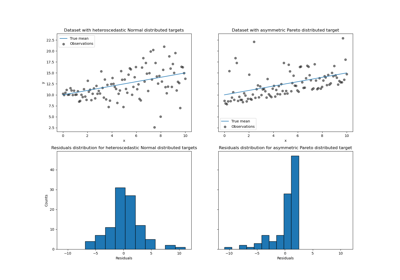sklearn.linear_model.QuantileRegressor¶
- class sklearn.linear_model.QuantileRegressor(*, quantile=0.5, alpha=1.0, fit_intercept=True, solver='interior-point', solver_options=None)[source]¶
Linear regression model that predicts conditional quantiles.
The linear
QuantileRegressoroptimizes the pinball loss for a desiredquantileand is robust to outliers.This model uses an L1 regularization like
Lasso.Read more in the User Guide.
New in version 1.0.
- Parameters:
- quantilefloat, default=0.5
The quantile that the model tries to predict. It must be strictly between 0 and 1. If 0.5 (default), the model predicts the 50% quantile, i.e. the median.
- alphafloat, default=1.0
Regularization constant that multiplies the L1 penalty term.
- fit_interceptbool, default=True
Whether or not to fit the intercept.
- solver{‘highs-ds’, ‘highs-ipm’, ‘highs’, ‘interior-point’, ‘revised simplex’}, default=’interior-point’
Method used by
scipy.optimize.linprogto solve the linear programming formulation. Note that the highs methods are recommended for usage withscipy>=1.6.0because they are the fastest ones. Solvers “highs-ds”, “highs-ipm” and “highs” support sparse input data and, in fact, always convert to sparse csc.- solver_optionsdict, default=None
Additional parameters passed to
scipy.optimize.linprogas options. IfNoneand ifsolver='interior-point', then{"lstsq": True}is passed toscipy.optimize.linprogfor the sake of stability.
- Attributes:
- coef_array of shape (n_features,)
Estimated coefficients for the features.
- intercept_float
The intercept of the model, aka bias term.
- n_features_in_int
Number of features seen during fit.
New in version 0.24.
- feature_names_in_ndarray of shape (
n_features_in_,) Names of features seen during fit. Defined only when
Xhas feature names that are all strings.New in version 1.0.
- n_iter_int
The actual number of iterations performed by the solver.
See also
LassoThe Lasso is a linear model that estimates sparse coefficients with l1 regularization.
HuberRegressorLinear regression model that is robust to outliers.
Examples
>>> from sklearn.linear_model import QuantileRegressor >>> import numpy as np >>> n_samples, n_features = 10, 2 >>> rng = np.random.RandomState(0) >>> y = rng.randn(n_samples) >>> X = rng.randn(n_samples, n_features) >>> reg = QuantileRegressor(quantile=0.8).fit(X, y) >>> np.mean(y <= reg.predict(X)) 0.8
Methods
fit(X, y[, sample_weight])Fit the model according to the given training data.
get_params([deep])Get parameters for this estimator.
predict(X)Predict using the linear model.
score(X, y[, sample_weight])Return the coefficient of determination of the prediction.
set_params(**params)Set the parameters of this estimator.
- fit(X, y, sample_weight=None)[source]¶
Fit the model according to the given training data.
- Parameters:
- X{array-like, sparse matrix} of shape (n_samples, n_features)
Training data.
- yarray-like of shape (n_samples,)
Target values.
- sample_weightarray-like of shape (n_samples,), default=None
Sample weights.
- Returns:
- selfobject
Returns self.
- get_params(deep=True)[source]¶
Get parameters for this estimator.
- Parameters:
- deepbool, default=True
If True, will return the parameters for this estimator and contained subobjects that are estimators.
- Returns:
- paramsdict
Parameter names mapped to their values.
- predict(X)[source]¶
Predict using the linear model.
- Parameters:
- Xarray-like or sparse matrix, shape (n_samples, n_features)
Samples.
- Returns:
- Carray, shape (n_samples,)
Returns predicted values.
- score(X, y, sample_weight=None)[source]¶
Return the coefficient of determination of the prediction.
The coefficient of determination \(R^2\) is defined as \((1 - \frac{u}{v})\), where \(u\) is the residual sum of squares
((y_true - y_pred)** 2).sum()and \(v\) is the total sum of squares((y_true - y_true.mean()) ** 2).sum(). The best possible score is 1.0 and it can be negative (because the model can be arbitrarily worse). A constant model that always predicts the expected value ofy, disregarding the input features, would get a \(R^2\) score of 0.0.- Parameters:
- Xarray-like of shape (n_samples, n_features)
Test samples. For some estimators this may be a precomputed kernel matrix or a list of generic objects instead with shape
(n_samples, n_samples_fitted), wheren_samples_fittedis the number of samples used in the fitting for the estimator.- yarray-like of shape (n_samples,) or (n_samples, n_outputs)
True values for
X.- sample_weightarray-like of shape (n_samples,), default=None
Sample weights.
- Returns:
- scorefloat
\(R^2\) of
self.predict(X)wrt.y.
Notes
The \(R^2\) score used when calling
scoreon a regressor usesmultioutput='uniform_average'from version 0.23 to keep consistent with default value ofr2_score. This influences thescoremethod of all the multioutput regressors (except forMultiOutputRegressor).
- set_params(**params)[source]¶
Set the parameters of this estimator.
The method works on simple estimators as well as on nested objects (such as
Pipeline). The latter have parameters of the form<component>__<parameter>so that it’s possible to update each component of a nested object.- Parameters:
- **paramsdict
Estimator parameters.
- Returns:
- selfestimator instance
Estimator instance.

